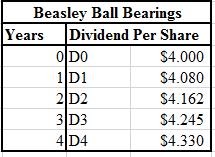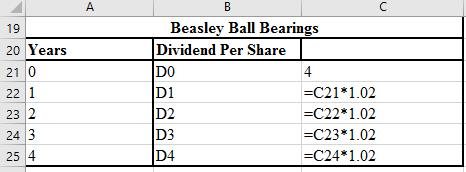
Concept explainers
Beasley Ball Bearings paid a
a. Compute the anticipated value of the dividends for the next four years. That is, compute
b. Discount each of these dividends back to present at a discount rate of 15 percent and then sum them.
c. Compute the price of the stock at the end of the fourth year
d. After you have computed
e. Add together the answers in part b and part d to get
f. Use Formula 10-8 to show that it will provide approximately the same answer as part e.
For Formula 10-8, use
g. If current EPS were equal to
h. By what dollar amount is the stock price in part g different from the stock price in part f?
i. In regard to the stock price in part
a.
To calculate: The anticipated value of dividends for the next four years to be declared by Beasley Ball Bearings.
Introduction:
Dividends:
It refers to the distribution of profits to the shareholders of the company and can be paid in terms of cash and stock by the company.
Answer to Problem 35P
The calculation for the next four anticipated dividends is shown below:

Explanation of Solution
The formulae used for the calculation of the anticipated dividends are shown below:

b.
To calculate: The summation of the present values of the four anticipated dividends discounted at the rate of 15% of Beasley Ball Bearings.
Introduction:
Present value:
The current value of an investment or an asset is termed as its present value. It is calculated by discounting the future value of the investment or asset.
Answer to Problem 35P
The calculation of the present values of the next four dividends is shown below:

Hence, the sum of the present value of the next four anticipated dividends is $11.961.
Explanation of Solution
The formula used in the calculation of the present values are shown below:

c.
To calculate: The price of the common stock at fourth year (P4), issued by Beasley Ball Bearings.
Introduction:
Share Price:
The highest price of one share of a company that an investor is willing to pay is termed as the share’s price. It is the current price used for the trading of such shares.
Answer to Problem 35P
The price of the stock at the end of the fourth year will be $33.977.
Explanation of Solution
Calculation of the stock price:
Working notes:
Calculation of the fifth year expected dividend:
d.
To calculate: The present value of P4 at a discount rate of 15% for Beasley Ball Bearings.
Introduction:
Present value:
The current value of an investment or an asset is termed as its present value. It is calculated by discounting the future value of the investment or asset.
Answer to Problem 35P
The present value of P4 at time zero discounted at 15% will be $19.435.
Explanation of Solution
Calculation of the present value of the stock price in part (c):
e.
To calculate: The current value of the stock.
Introduction:
Present value:
The current value of an investment or an asset is termed as its present value. It is calculated by discounting the future value of the investment or asset.
Share Price:
The highest price of one share of a company that an investor is willing to pay is termed as the share’s price. It is the current price used for the trading of such shares.
Answer to Problem 35P
The current value of the stock is $31.401.
Explanation of Solution
Calculation of the current price of the stock:
f.
To calculate: The current value of the stock.
Introduction:
Share Price:
The highest price of one share of a company that an investor is willing to pay is termed as the share’s price. It is the current price used for the trading of such shares.
Answer to Problem 35P
The price of the stock is $31.385. This price is approximately the same as calculated in the part (e).
Explanation of Solution
Calculation of the stock price by using the formula 10-8:
g.
To calculate: The current value of the stock.
Introduction:
Share Price:
The highest price of one share of a company that an investor is willing to pay is termed as the share’s price. It is the current price used for the trading of such shares.
Answer to Problem 35P
The price of the stock is $35.86.
Explanation of Solution
Calculation of the price of the stock:
Working Notes:
Calculation of firm’s P/E ratio:
h.
To calculate: The difference between the stock price calculated in part (g) and part (f) for Beasley Ball Bearings.
Introduction:
Share Price:
The highest price of one share of a company that an investor is willing to pay is termed as the share’s price. It is the current price used for the trading of such shares.
Answer to Problem 35P
The dollar amount difference between the stock price in part (g) and part (f) is $4.47.
Explanation of Solution
Calculation of the difference between the stock price in part (g) and part (f):
i.
To calculate: The effect of changing variables on the stock price.
Introduction:
Share Price:
The highest price of one share of a company that an investor is willing to pay is termed as the share’s price. It is the current price used for the trading of such shares.
Answer to Problem 35P
The price of the stock will increase in the 1st and 3rd parts, whereas it will decrease in the 2nd part.
Explanation of Solution
(1) If D1 increases, then the stock price will go up. The stock price and the amount of dividend are positively related to one another.
(2) If the required rate of return increases the stock price will decrease, exhibiting an inverse relationship.
(3) If the growth rate (g) increases, then the price of the stock will also increase. They exhibit a positive relationship.
Want to see more full solutions like this?
Chapter 10 Solutions
Foundations Of Financial Management
- You own a company. This company’s projected revenue is $30,000 for year 1, $31,000 for year 2, and $32,000 for year 3. From the 4th year onwards, revenue is expected to be 5% higher than the previous year. Assume the appropriate nominal discount rate is 8%, and all revenue is collected at the end of each year. Determine the present value of your sales revenue for the first 15 years, round to 2 decimal places. [show the step by step of how to find each result]arrow_forwardYou own a company. This company’s projected revenue is $30,000 for year 1, $31,000 for year 2, and $32,000 for year 3. From the 4th year onwards, revenue is expected to be 5% higher than the previous year. Assume the appropriate nominal discount rate is 8%, and all revenue is collected at the end of each year.Determine the present value of your sales revenue for the first 15 years, round to 2 decimal places.arrow_forwardSuppose you receive$130 at the end of each year for the next three years. a. If the interest rate is10%, what is the present value of these cash flows? b. What is the future value in three years of the present value you computed in(a)? c. Suppose you deposit the cash flows in a bank account that pays 10%interest per year. What is the balance in the account at the end of each of the next three years (after your deposit is made)? How does the final bank balance compare with your answer in (b)?arrow_forward
- 3) What is the future value at the end of year 20 of a series of 16 deposits? The first deposit occurs at the end of year 5 and is $800. The remaining deposits increase by $150/year (so the last deposit will be $3,050 and will occur at the end of year 20). Assume i = 9% annual rate compounded annually. Answer 4) Your business is expected to generate a $40,000 profit at the end of year 1, and profit will increase by 7% per year through year 10. If you can earn 10% annual interest compounded annually, what is the present value of all your profits over the next 10 years? Answerarrow_forwardSuppose the Omega Graphics Company wishes to set aside an equal, annual, end-of-year amount in a “sinking fund account” earning 8.5 percent per annum over the next six years. The firm wants to have $5 million in the account at the end of six years to retire (pay off ) $5 million in outstanding bonds. How much must be deposited in the account at the end of each year? Hint: Use the math formula.arrow_forwardAssume that at the beginning of the year, you purchase an investment for $6,300 that pays $130 annual income. Also assume the investment's value has increased to $6,900 by the end of the year. a. What is the rate of return for this investment? Note: Input the amount as a positive value. Enter your answer as a percent rounded to 2 decimal places. Rate of return % b. Is the rate of return a positive or a negative number? Positive Negativearrow_forward
- An investment will pay you $87,000 in five years. Assume the appropriate discount rate is 7.75 percent compounded daily. What is the present value? (Do not round intermediate calculations and round your answer to 2 decimal places, e.g., 32.16. Use 365 days in a year.)arrow_forwardAssume that at the beginning of the year, you purchase an investment for $6,500 that pays $95 annual income. Also assume the investment's value has increased to $7,050 by the end of the year. a. What is the rate of return for this investment? Note: Input the amount as a positive value. Enter your answer as a percent rounded to 2 decimal places.arrow_forwardConsider a series of $1,438 annual cash flows that goes on forever, with the first cash flow occurring one year from today. If the discount rate is 4%, what is the present value of this series of cash flows? Round your answer to the nearest penny. Previous Nextarrow_forward
- An investment account offers a 12% annual return. If $50,000 is placed in the account for two years, by how much will the investment grow if interest is compounded (a) annually, (b) semiannually, (c) quarterly, or (d) monthly? (FV of $1, PV of $1, FVA of $1, and PVA of $1) (Use tables, Excel, or a financial calculator. Round your answers to 2 decimal places.)arrow_forwardSuppose that $70,000 is invested at 7% interest. Find the amount of money in the account after 7 years if the interest is compounded annually. If interest is compounded annually, what is the amount of money after t = 7 years? $ (Do not round until the final answer. Then round to the nearest cent as needed.)arrow_forwardSuppose you make a one-time $ 8,000 investment into an account that yields a 12% annual return. If you keep the account for 10 years, what should be the account balance? Round your answer to 2 decimal placesarrow_forward
 Essentials Of InvestmentsFinanceISBN:9781260013924Author:Bodie, Zvi, Kane, Alex, MARCUS, Alan J.Publisher:Mcgraw-hill Education,
Essentials Of InvestmentsFinanceISBN:9781260013924Author:Bodie, Zvi, Kane, Alex, MARCUS, Alan J.Publisher:Mcgraw-hill Education,

 Foundations Of FinanceFinanceISBN:9780134897264Author:KEOWN, Arthur J., Martin, John D., PETTY, J. WilliamPublisher:Pearson,
Foundations Of FinanceFinanceISBN:9780134897264Author:KEOWN, Arthur J., Martin, John D., PETTY, J. WilliamPublisher:Pearson, Fundamentals of Financial Management (MindTap Cou...FinanceISBN:9781337395250Author:Eugene F. Brigham, Joel F. HoustonPublisher:Cengage Learning
Fundamentals of Financial Management (MindTap Cou...FinanceISBN:9781337395250Author:Eugene F. Brigham, Joel F. HoustonPublisher:Cengage Learning Corporate Finance (The Mcgraw-hill/Irwin Series i...FinanceISBN:9780077861759Author:Stephen A. Ross Franco Modigliani Professor of Financial Economics Professor, Randolph W Westerfield Robert R. Dockson Deans Chair in Bus. Admin., Jeffrey Jaffe, Bradford D Jordan ProfessorPublisher:McGraw-Hill Education
Corporate Finance (The Mcgraw-hill/Irwin Series i...FinanceISBN:9780077861759Author:Stephen A. Ross Franco Modigliani Professor of Financial Economics Professor, Randolph W Westerfield Robert R. Dockson Deans Chair in Bus. Admin., Jeffrey Jaffe, Bradford D Jordan ProfessorPublisher:McGraw-Hill Education





